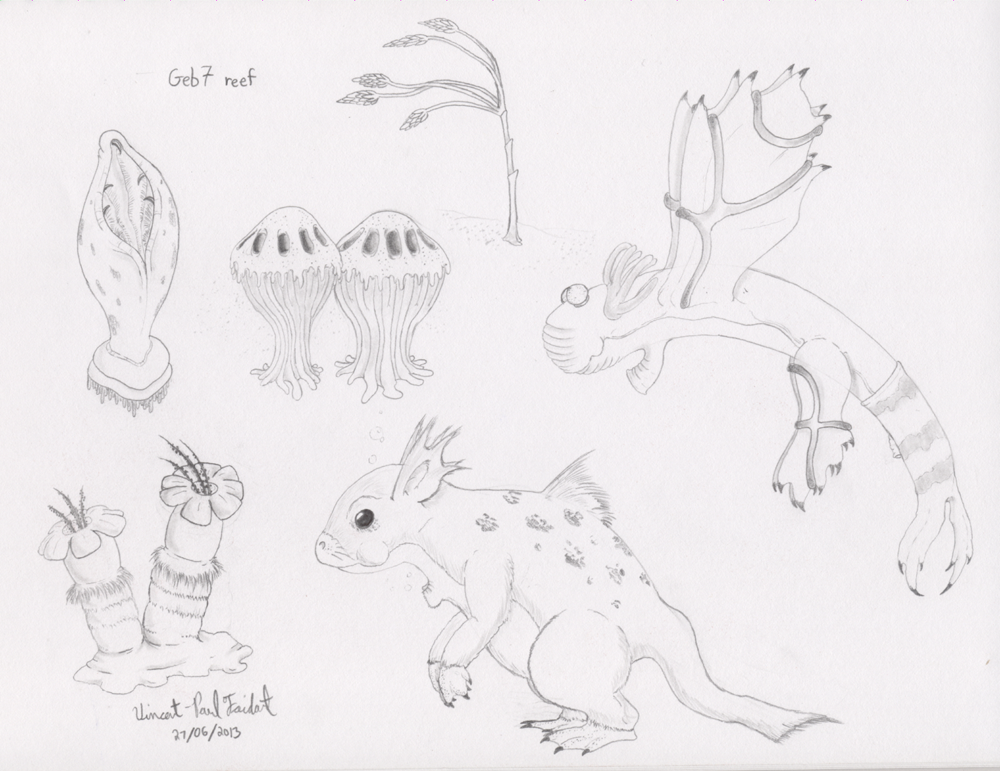HOME | DD
 Tapejara — Key Life Forms of Geb's Reef
Tapejara — Key Life Forms of Geb's Reef

Published: 2013-06-28 03:47:34 +0000 UTC; Views: 1524; Favourites: 20; Downloads: 3
Redirect to original
Description
Near the North-Western shoreline, there is a "reef" that supports a great variety of organisms. It's not a coral reef like on Earth since Geb doesn't have any coral-like lifeforms. It's more of a garden full of a variety of aquatic grasses, seroinsolituses and flowering plants.From left to right:
Caerolabias
Name derives from Caeruleo (blue) and Labia (lips)
This carnivorous plant is actually very safe for most large lifeforms to be around. In fact, their fearsome appearance is merely to scare off herbivores. Small piscivultuses enter the cavity which is lined with brush like hairs. The hairs scrape off parasites which the Caerolabias eats.
Venenafas
Name derives from Venenum (poison) and Afa (dust)
These seroinsolituses grow in small colonies, filtering the water for organic matter they consume. To defend themselves, any strong bump against them will release poisonous spores that can enter the gill tract of piscivultuses and cause suffocation.
Herbaventis
Name derives from Herba (grass) and Ventulus (wind)
Generic sea grass that drifts in the current. The capsules break off when they mature to spread seeds.
Irivermis
Name derives from Iris (Rainbow) and Vermis (Worm)
The strong limbs of these pararthropods are used to help them dig through the mud. Feeding on dead matter, they convert it into fertile soil critical for the garden's survival. Their bright colors help warn attackers that they possess a foul taste.
Tuboflos
Name derives from Tubus (tube) and Flos (flower)
Capable of resisting the strongest tides, these are the most successful flowers of the garden but also those who take the longest to grow. Inside the flowers rests a denser than water nectar that serves as food for many animals. To reach it, most of them have to brush against the growths that hold sticky seeds.
Aquamuris
Name derives from Aqua (water) and Muris (mouse)
These water bound Breviguttervultuses are one of the only animals that can feed on the Irivermis. The live in burrows on the garden floor and emerge only to breathe or find alternate food such as nectar. Rather than rising to the surface which is quite a distance away, they go after a certain plant that holds the oxygen in releases into capsules. Their breathing tubes are unique, appearing as two extendable nozzles.
Related content
Comments: 1

* ¡Fantástico trabajo! Lo hemos destacado dentro de la carpeta "Featured nº5 o Destacados nº 5" en Special-Groups. (Es la carpeta donde se exhiben los mejores trabajos del grupo).
¡Por favor, queremos ver más trabajos tuyos en el grupo!.
* Fantastic work! Featured in Special-Groups in folder Featured nº 5. (Best works of the group).
Please, We want to see more works in the group of you!.
👍: 0 ⏩: 0

























